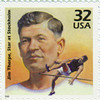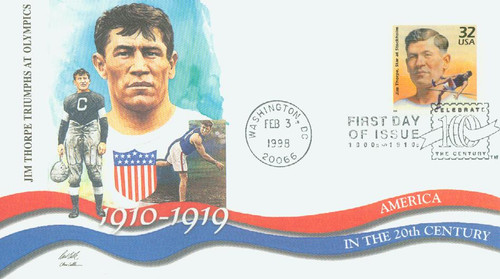
# 3183g - 1998 32c Celebrate the Century - 1910s: Jim Thorpe
32¢ Jim Thorpe at Stockholm Olympics
Celebrate the Century – 1910s
City: Washington, DC
Quantity: 12,533,000
Printed By: Ashton-Potter (USA) Ltd
Printing Method: Lithographed
Perforations: 11.5
Color: Multicolored
Happy Birthday Jim Thorpe
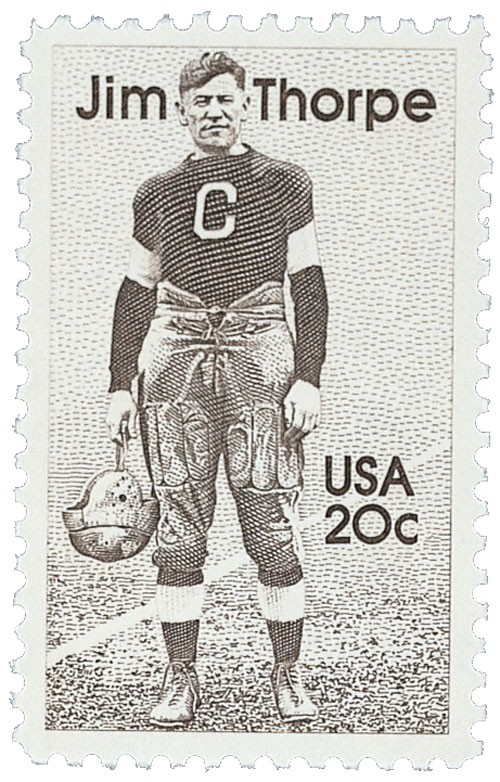
Jim Thorpe claimed he was born on May 28, 1888, though some sources say he was born on May 22, 1887.
Thorpe was born in Indian Territory and baptized in the Catholic Church, though his birth certificate has never been found. In an interview later in life, Thorpe claimed, he was born “on his mother’s allotment” near and south of Bellemont – Pottawatomie County – along the banks of the North Fork River … hope this will clear up the inquiries as to my birthplace.” The town of Prague, Oklahoma considers it his birthplace, but there’s little evidence of that.
Born to an Irish father and Sac and Fox Indian mother, Thorpe was raised Native American. His name was Wa-Tho-Huk, which means “path lit by great flash of lightning” or “Bright Path.” He was named for light that brightened the path to the cabin where he was born.
Thorpe attended school with his twin brother Charlie until he died of pneumonia at the age of nine. Thorpe frequently ran away from school before he was sent to an Indian boarding school in Lawrence, Kansas. After briefly leaving home to work on a horse ranch, Thorpe attended the Carlisle Indian Industrial School in Pennsylvania. There he realized his athletic ability under the guidance of Glen Scobey “Pop” Warner.
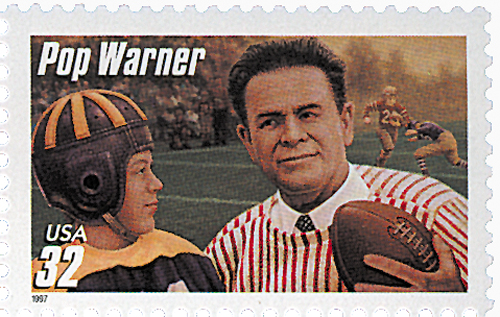
In 1907, Thorpe was walking past the track watching the high jumpers. Interested, he gave it a try and jumped higher than any of them – 5-feet-9-inches – in street clothes. He soon began playing football, baseball, and lacrosse. He even won the intercollegiate ballroom dancing championship in 1912.
Thorpe left Carlisle to play two seasons of minor league baseball, but returned in 1911. Pop Warner was initially hesitant to allow Thorpe to play physical sports like football, for fear he’d get hurt and ruin his chances at a track and field career. But he was able to run through the field without getting touched.
Thorpe first gained national attention in 1911 when he played running back, defensive back, placekicker, and punter in a single game. Scoring four field goals and touchdown, he earned all of the team’s points in their 18 to 15 victory over Harvard. The team went on to win 11 out of 12 games that season and win the national collegiate championship thanks to Thorpe, who scored 25 touchdowns and 198 points that season.
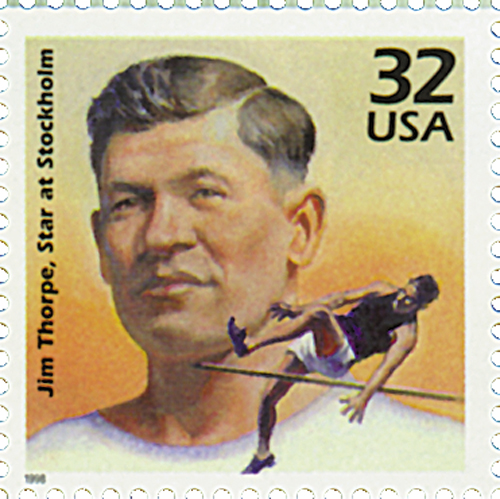
Though football was Thorpe’s favorite sport, he would soon gain international fame for his track and field abilities. In the 1912 Olympics, Thorpe became the first athlete to win both the decathlon and the pentathlon. His score of 8,412 points in the decathlon was not exceeded for 15 years. However, Thorpe’s medals were taken away from him when it was discovered he had received a small salary for playing baseball, a violation of his amateur status. Thorpe’s medals were posthumously returned to him in 1982, and his name was returned to the list of 1912 Olympic champions.
From 1913 to 1919, Thorpe played professional baseball for three major league teams. After a brief stint playing minor league baseball, he returned to his passion, football. Between 1915 and 1930, he played with seven professional football teams. During this time Thorpe also played basketball, traveling New York and Pennsylvania as part of “Jim Thorpe and his World-Famous Indians.”
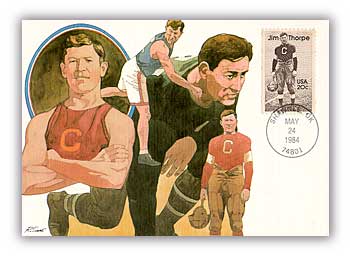
Thorpe’s fame helped to establish football as a popular sport. In 1920 he became the National Football League’s first commissioner. When his athletic career came to an end, Thorpe struggled to support his family. He held a variety of jobs in his later years, including movie extra, construction worker, bouncer, security guard, ditch digger, and merchant marine. In 1950 he was admitted to the hospital for lip cancer. Since he had no money he was admitted as a charity case. His wife addressed the media claiming, “We’re broke … Jim has nothing but his name and his memories. He has spent money on his own people and has given it away. He has often been exploited.” He passed away three years later on March 28, 1953.
32¢ Jim Thorpe at Stockholm Olympics
Celebrate the Century – 1910s
City: Washington, DC
Quantity: 12,533,000
Printed By: Ashton-Potter (USA) Ltd
Printing Method: Lithographed
Perforations: 11.5
Color: Multicolored
Happy Birthday Jim Thorpe

Jim Thorpe claimed he was born on May 28, 1888, though some sources say he was born on May 22, 1887.
Thorpe was born in Indian Territory and baptized in the Catholic Church, though his birth certificate has never been found. In an interview later in life, Thorpe claimed, he was born “on his mother’s allotment” near and south of Bellemont – Pottawatomie County – along the banks of the North Fork River … hope this will clear up the inquiries as to my birthplace.” The town of Prague, Oklahoma considers it his birthplace, but there’s little evidence of that.
Born to an Irish father and Sac and Fox Indian mother, Thorpe was raised Native American. His name was Wa-Tho-Huk, which means “path lit by great flash of lightning” or “Bright Path.” He was named for light that brightened the path to the cabin where he was born.
Thorpe attended school with his twin brother Charlie until he died of pneumonia at the age of nine. Thorpe frequently ran away from school before he was sent to an Indian boarding school in Lawrence, Kansas. After briefly leaving home to work on a horse ranch, Thorpe attended the Carlisle Indian Industrial School in Pennsylvania. There he realized his athletic ability under the guidance of Glen Scobey “Pop” Warner.

In 1907, Thorpe was walking past the track watching the high jumpers. Interested, he gave it a try and jumped higher than any of them – 5-feet-9-inches – in street clothes. He soon began playing football, baseball, and lacrosse. He even won the intercollegiate ballroom dancing championship in 1912.
Thorpe left Carlisle to play two seasons of minor league baseball, but returned in 1911. Pop Warner was initially hesitant to allow Thorpe to play physical sports like football, for fear he’d get hurt and ruin his chances at a track and field career. But he was able to run through the field without getting touched.
Thorpe first gained national attention in 1911 when he played running back, defensive back, placekicker, and punter in a single game. Scoring four field goals and touchdown, he earned all of the team’s points in their 18 to 15 victory over Harvard. The team went on to win 11 out of 12 games that season and win the national collegiate championship thanks to Thorpe, who scored 25 touchdowns and 198 points that season.

Though football was Thorpe’s favorite sport, he would soon gain international fame for his track and field abilities. In the 1912 Olympics, Thorpe became the first athlete to win both the decathlon and the pentathlon. His score of 8,412 points in the decathlon was not exceeded for 15 years. However, Thorpe’s medals were taken away from him when it was discovered he had received a small salary for playing baseball, a violation of his amateur status. Thorpe’s medals were posthumously returned to him in 1982, and his name was returned to the list of 1912 Olympic champions.
From 1913 to 1919, Thorpe played professional baseball for three major league teams. After a brief stint playing minor league baseball, he returned to his passion, football. Between 1915 and 1930, he played with seven professional football teams. During this time Thorpe also played basketball, traveling New York and Pennsylvania as part of “Jim Thorpe and his World-Famous Indians.”

Thorpe’s fame helped to establish football as a popular sport. In 1920 he became the National Football League’s first commissioner. When his athletic career came to an end, Thorpe struggled to support his family. He held a variety of jobs in his later years, including movie extra, construction worker, bouncer, security guard, ditch digger, and merchant marine. In 1950 he was admitted to the hospital for lip cancer. Since he had no money he was admitted as a charity case. His wife addressed the media claiming, “We’re broke … Jim has nothing but his name and his memories. He has spent money on his own people and has given it away. He has often been exploited.” He passed away three years later on March 28, 1953.






